![]()
![]()
![]()
Use LEFT and RIGHT arrow keys to navigate between flashcards;
Use UP and DOWN arrow keys to flip the card;
H to show hint;
A reads text to speech;
21 Cards in this Set
- Front
- Back
|
When does the first sound occur?
What stage does this occur in relation to ventricular volume/ chart? |
When ventricular pressure becomes greater than atrial pressure, AV valves close and the sound the blood makes slamming the wall is this sound
- this is at the beginning of the isovolumetric ventricular stage - During beginning of B |
|
|
Describe the second heart sound or S2 and what phase does this occur??
What is splitting and when does this occur? |
At end of the T wave when the ventricles are repolarized the aortic valves close (as well as pulmonic valve) This is the second heart sound.
This is during the E phase or isovolumetric ventricular relaxation phase - Inspiration causes splitting of the second heart sound due to greater volume of blood being drawh into right ventricle |
|
|
Describe the cause and time of the third heart sound...
|
Rapid flow of blood from atria into the ventricle during F on EKG... between T wave and P.
|
|
|
Describe the cause and time of the third heart sound compare to fourth heart sound...
|
this sound is from the contraction of the atrium opposed to the simple opening of the valves (mitral and tricuspid) and filling that cause the 3rd sound
|
|
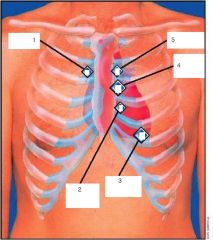
Label the points of Auscultation
|
1. Aortic valve
2. Tricuspid area 3. Mitral area 4. 5. Pulmonic valve |
|
|
If you suspect a murmur how do you know where it is occuring and what type of murmur it is? (step by step explanation)
|
1. First your need to determine if it is between beat 1-2 or 2-1...
2. Then listen to specific regions of thorax to determine which valve is causing problem 3. IF heard during 1-2 sounds a problem on mitral or tricuspid valves indicates regurgitation because they should be closed at that time. But if heard at aortic or pulmonary valve areas then it is "systolic stenosis" because they should be open at that time |
|
|
What causes a heart murmur and name the main types...
|
Murmur is an abnormal sound of flowing blood and is either heard between S1-S2 (systolic) or S2-S3 (diastolic)
|
|
|
Describe what a systolic murmur is and the types...
|
Abnormal sound heard between S1 and S2 during ejection (S1= sound 1, and S2= sound 2).
Types: Stenosis: incomplete opening of semilunar valves (aortic or pulmonic stenosis) Regurgication: incomplete closing of AV valves (mitral or tricuspid regurgitation) |
|
|
Describe what a diastolic murmur is and the types...
|
Abnormal sound flowing blood following S2 but before S1
Types: Stenosis: Incomplete opening of AV valve (mitral or tricuspid stenosis) Regurgitation: Incomplete closing of Semi lunar valves (aortic or pulmonic regurgitation) |
|

If you hear a murmur in between the first and second sound at the location pointed by red arrow... what is most likely type of murmur?
|
This is the aortic valve auscultation point and since it is occuring during S1-S2 we know it is supposed to be open, which means a murmur is a stenosis problem (problem opening)
Therefore AORTIC STENOSIS |
|

At this location pointed to by red arrow, you hear a murmur between S2 and S1. What is most likely type of murmur?
|
AORTIC REGURGITATION...
Between S2 and S1 aortic valves should be closed and since you hear a murmur you can assume it is a problem closing... or aortic regurgitation... bitch |
|
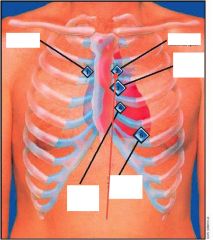
You hear a murmur hear between S1 and S2 at this point (red arrow) what is type of murmur?
|
PULMONIC STENOSIS
-you know that between S1 and S2 pulmonary valve should be close and since this is area of pulmonic auscultation you know this is a stenosis |
|
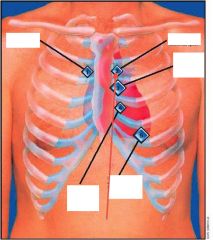
You hear a murmur hear between S2 and S1 at this point (red arrow) what is type of murmur?
|
PULMONIC REGURGITATION
- You know that this is the auscultation point of pulmonary valve - Therefore you know it should be closed between S2 and S1 so pulmonary regurgitation |
|
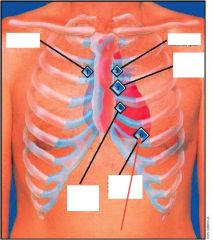
If you hear a murmur between S1 and S2 at this point what would you diagnose?
|
MITRAL VALVE REGURGITATION
- You know its mitral valve by the auscultation point location... and you know between S1 and S2 it is supposed to be close, so its a problem closing i.e. regurgitation |
|
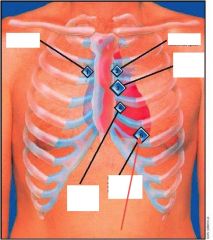
You hear a murmur at this point between S2 and S1 what do you suspect?
|
MITRAL VALVE STENOSIS
You know its mitral valve by the auscultation point location... and you know between S2 and S1 it should be opened. It is a problem opening so it is stenosis |
|
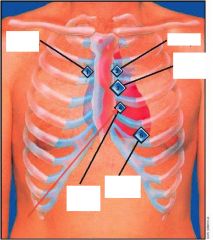
You hear a murmur at the point indicated by the red arrow between S1 and S2... What do you expect?
|
Tricuspid regurgitation
- You know this is the auscultation point for the tricuspid valve and that between the S1 and S2 sounds it should be closed... therefore a murmur is a problem with the closing or a regurgitation |
|
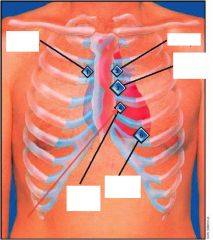
By listening at the red point you hear a murmur between S2 and S1 what would you call this?
|
Tricuspid stenosis
- You know this is the auscultation point for the tricuspid valve and that between the S2 and S1 sounds it should be close... therefore a murmur is a problem with the opening or a stenosis |
|
|
During mitral valve stenosis what would you see on a graph of left atrial/ventricular pressure?
When during pumping phase would you see it? |
This would occur after T wave and before P wave (during diastole)
- Normally during this time the pressure in the L atrium and Ventricle are very similar because the mitral valve is open. If there is a stenosis (problem opening) then there will be more pressure in the Left atrium |
|
|
What differences from normal on a graph of Atrial and Ventricular pressure would you expect to see on for mitral regurgitation?
|
We know that this is during systole so Mitral valve should be closing but it is not so some blood from ventricle is "regurgitated" to L atrium causing a rise in the L atrial pressure shown on a graph
|
|
|
What differences from normal on a graph of Left ventricle and Aortic pressure would you expect to see for a Aortic stenosis?
|
You know that this is a problem opening the aortic valve, which opens during systole. So this should show a huge ventricle build up but it does not mimic Aortic pressure like it should
|
|
|
What differences from normal on a graph of Left ventricle and Aortic pressure would you expect to see for a Aortic regurgitation?
|
We know that it is a problem with aortic valve closing. When it usually closes during diastole we will see a slight drop in pressure but when it regurgitates into ventricle instead of closing it shows a higher diastolic pressure (ventricular pressure) and if we had a volume graph we would see no isovolumic stage for the L ventricle.
|

